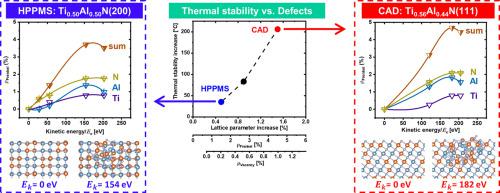Acta Materialia ( IF 8.3 ) Pub Date : 2023-03-22 , DOI: 10.1016/j.actamat.2023.118864 Soheil Karimi Aghda , Damian M. Holzapfel , Denis Music , Yeliz Unutulmazsoy , Stanislav Mráz , Dimitri Bogdanovski , Gönenç Fidanboy , Marcus Hans , Daniel Primetzhofer , Alba San José Méndez , André Anders , Jochen M. Schneider

|
Ion-irradiation-induced changes in structure, elastic properties, and thermal stability of metastable c-(Ti,Al)N thin films synthesized by high-power pulsed magnetron sputtering (HPPMS) and cathodic arc deposition (CAD) are systematically investigated by experiments and density functional theory (DFT) simulations. While films deposited by HPPMS show a random orientation at ion kinetic energies ()>105 eV, an evolution towards (111) orientation is observed in CAD films for >144 eV. The measured ion energy flux at the growing film surface is 3.3 times larger for CAD compared to HPPMS. Hence, it is inferred that formation of the strong (111) texture in CAD films is caused by the ion flux- and ion energy-induced strain energy minimization in defective c-(Ti,Al)N. The ion energy-dependent elastic modulus can be rationalized by considering the ion energy- and orientation-dependent formation of point defects from DFT predictions: The balancing effects of bombardment-induced Frenkel defects formation and the concurrent evolution of compressive intrinsic stress result in the apparent independence of the elastic modulus from for HPPMS films without preferential orientation. However, an ion energy-dependent elastic modulus reduction of ∼18% for the CAD films can be understood by considering the 34% higher Frenkel pair concentration formed at =182 eV upon irradiation of the experimentally observed (111)-oriented (Ti,Al)N in comparison to the (200)-configuration at similar . Moreover, the effect of Frenkel pair concentration on the thermal stability of metastable c-(Ti,Al)N is investigated by differential scanning calorimetry: Ion-irradiation-induced increase in Frenkel pairs concentration retards the wurtzite formation temperature by up to 206 °C.
中文翻译:

(Ti,Al)N 薄膜的离子动能和离子通量依赖性机械性能和热稳定性
通过实验系统地研究了离子辐照诱导的高功率脉冲磁控溅射 (HPPMS) 和阴极电弧沉积 (CAD) 合成的亚稳态 c-(Ti,Al)N 薄膜的结构、弹性和热稳定性变化和密度泛函理论 (DFT) 模拟。虽然 HPPMS 沉积的薄膜在离子动能下显示出随机取向()>105 eV,在 CAD 薄膜中观察到向 (111) 方向的演变>144 电子伏特。与 HPPMS 相比,CAD 在生长薄膜表面测得的离子能量通量是 3.3 倍。因此,可以推断 CAD 薄膜中强 (111) 织构的形成是由缺陷 c-(Ti,Al)N 中的离子通量和离子能量诱导的应变能最小化引起的。离子能量相关的弹性模量可以通过考虑 DFT 预测的离子能量和取向相关的点缺陷形成来合理化:轰击引起的 Frenkel 缺陷形成的平衡效应和压缩内在应力的同时演化导致表观弹性模量的独立性对于没有优先取向的 HPPMS 薄膜。然而,考虑到 34% 的弗伦克尔对浓度在=182 eV 在实验观察到的 (111) 定向 (Ti,Al)N 与类似的 (200)-配置相比. 此外,通过差示扫描量热法研究了 Frenkel 对浓度对亚稳态 c-(Ti,Al)N 的热稳定性的影响:离子辐射引起的 Frenkel 对浓度增加使纤锌矿形成温度延迟高达 206 °C .











































 京公网安备 11010802027423号
京公网安备 11010802027423号